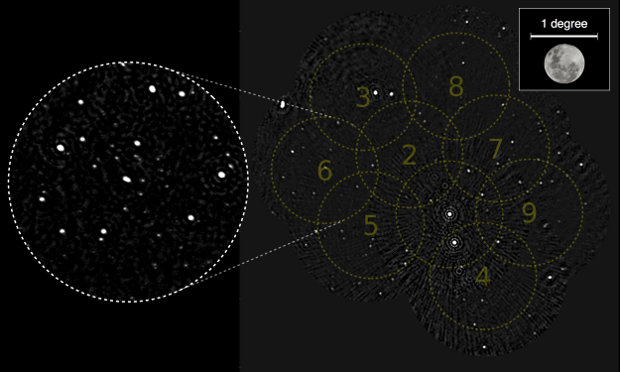
The “Advancing Astrophysics with the Square Kilometre Array” meeting was held this week in the Giardini Naxos, Messina, Italy to talk about the latest updates of the SKA (Square Kilometer Array) project, the next-generation radio telescope that is expected to come into operation in 2020. The participants discussed the latest developments in the field of astrophysics and of course the research needed to complete the SKA project. The first picture taken by ASKAP (Australian SKA Pathfinder) was also showed as it’s one of the radio telescopes already under construction that will be integrated into the SKA.
It’s been a little over two years since the sites were chosen where they’ll build the antennas that will form the final SKA array in South Africa and Australia plus New Zealand. Several other nations are collaborating to the project although a few days ago Germany announced that it will no longer be part of it. The CSIRO (Commonwealth Scientific and Industrial Research Organisation) has already built in Australia a part of the ASKAP radio telescope, one of the SKA’s precursors, which now entered the test phase.
In this phase, 6 of the 36 antennas of the ASKAP form a small test array called BETA. It’s used to develop and test the technologies that will later be implemented in the SKA but is already a full fledged radio telescope. In the first test, this small array has captured an image of distant galaxies.
The image is the result of 12 hours of observation. The final photograph is 50 times larger than the full Moon and was created by observing 9 regions of the sky called “beams” at the same time. The technologies implemented in the ASKAP allow great versatility in the size and shape of the beams to suit the needs of different observations.
The image obtained isn’t anything spectacular but proves that the ASKAP works as expected even in the very small configuration used for the test. To take the photo, the small array took half the time any other comparable existing telescope in the Southern Hemisphere would take.
It will take years before we can see the results of the SKA project but the first technological and scientific advances are already arriving. This means that we can hope to have at least some clue that will bring us closer to the answers to the fundamental mysteries of the universe even before the SKA is fully operational.
[ad name=”eBayUSUKAstronomy”]


Permalink
I would just like to understand, what exactly are “the fundamental mysteries of the universe” that the SKA project will help solve? What is the significance of the SKA project in the field of Science?
Permalink
The main mysteries SKA will help to solve concern the nature of dark matter and dark energy. There will be also more detailed observation of the boundaries of the universe to investigate its birth.
Consider that the research into the infinitely big and infinitely small mix up so SKA’s observations will help particle physics. For example, with more information about dark matter it will be possible to understand what kind of particle dark matter is made of.
Permalink
Interesting. How exactly these observations be obtained??? How does SKA work??
Permalink
Basically a series of antennas work together combining the radio waves they detect like they were one single antenna even if they’re scattered throughout a huge area. SKA will have antennas on different continents so it will combine data from a really huge area reaching a sensitivity never obtained so far.
Permalink
So how will SKA be different from normal Radio Telescope??
Permalink
Size matters. 😉 SKA will be like a radiotelescope the size of half the Earth, by far the biggest ever existed. It will gather an unprecedented amount of data, so much the IBM is developing a new generation of computers to handle them.
Permalink
Oh, wow… I read somewhere that the SKA’s observations and findings will also be used to further investigate Einstein’s Theory of Relativity and gravity?? Why is that? How is the findings and observations going to contribute to that?? Is his theory wrong, or missing some important facts??
Permalink
The problem with Einstein’s theory of Relativity is that we still can’t really combine it with quantum theory. Possibly there’s a more complete theory that includes both relativistic and quantum phenomena. Studying gravity with unprecedented level of precision can give us a chance to see if there are clues to such a unified theory.
Permalink
Will the be used in investigate the possibility of extraterrestrial life?? And if yes, how??
Permalink
SKA might be used to search signals originated by extraterrestrial sentient beings. That’s because it will be able to detect a vast amount of radio signals so if there are other aliens who used or are using them to communicate SKA might catch them.
Permalink